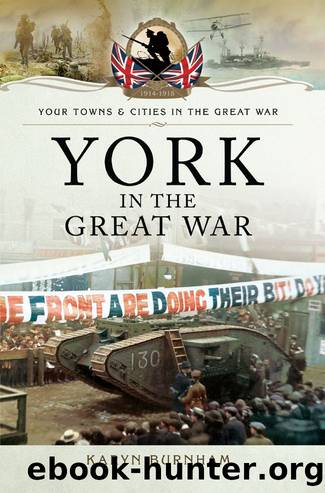York in the Great War by Burnham Karyn

Author:Burnham, Karyn
Language: eng
Format: epub
Publisher: Pen and Sword
Published: 2014-11-29T00:00:00+00:00
Corder Catchpool – Unlikely Hero
Bootham School in York is a Quaker establishment and had strong links to the pacifist movement during the First World War, with schoolmasters of fighting age applying for exemption to military service on grounds of conscience. Although some students went on to enlist, others also adopted a pacifist position and became conscientious objectors. One such student was Corder Catchpool, who attended Bootham from 1900 – 1902. Although he was not a resident of York by the time of the war, the account of his wartime experiences, recorded in the Bootham School Magazine is worth mentioning here as an example of the complexities of conscientious objection.
Towards the end of 1914, an entirely voluntary relief service was founded by Quaker Philip Baker to provide emergency medical aid to soldiers in Belgium. The First Anglo-Belgian Ambulance Service, which later became more famously known as the Friends’ Ambulance Unit, set sail for Dunkirk at the end of October. The unit comprised of forty-three men, one of whom was Corder Catchpool.
The events recorded in the Bootham School Magazine are based on an extract of a letter dated 30 April 1915, written by Catchpool while he was serving with the FAU near Ypres. He was experiencing his first period of calm after eight days in the midst of furious fighting. Catchpool wrote his letter while sitting in the garden of the College of St Stanislas, where his unit had been billeted for the previous five months. That first evening of peace seemed ‘infinitely sweet’ after the ‘awful turmoil, the bodily fatigue and the mental strain’ of the previous eight days, during which time he had not once removed either his jacket or boots, let alone slept.
Catchpool described passing by the ruined city of Ypres and seeing its rubble being shelled afresh by German siege guns. As his ambulance headed towards the reserve trenches, the surrounding villages were being used as target practice and the air was heavy with acrid smoke. When the message came that the Germans had ‘broken through’, the ambulances headed past the reserve trenches and were met by staggering columns of gassed men ‘choking, gasping, dying, asphyxiated’. Throughout the night the FAU travelled the 8 kilometres to the rail head and back several times, taking as many men as they could move. German troops gained ground to within 3 kilometres of the village where ambulances were picking up the wounded.
The battle raged for five days without any let up. Wounded men continued to pour into the village and were transported to safety by the FAU, until one driver was injured and two ambulances were damaged by shell fire. The rail head had also come under shell fire and the ambulance journeys were becoming increasingly perilous. At one stage, the lanes were blocked by piles of earth thrown up by exploding shells; Catchpool, along with the other FAU drivers and orderlies, moved the earth with their hands and feet to clear the way, before driving carefully over the debris.
When the
Download
This site does not store any files on its server. We only index and link to content provided by other sites. Please contact the content providers to delete copyright contents if any and email us, we'll remove relevant links or contents immediately.
Shoot Sexy by Ryan Armbrust(17139)
Portrait Mastery in Black & White: Learn the Signature Style of a Legendary Photographer by Tim Kelly(16483)
Adobe Camera Raw For Digital Photographers Only by Rob Sheppard(16383)
Photographically Speaking: A Deeper Look at Creating Stronger Images (Eva Spring's Library) by David duChemin(16159)
Bombshells: Glamour Girls of a Lifetime by Sullivan Steve(13107)
Art Nude Photography Explained: How to Photograph and Understand Great Art Nude Images by Simon Walden(12346)
Perfect Rhythm by Jae(4621)
Pillow Thoughts by Courtney Peppernell(3394)
The Book of Joy by Dalai Lama(3217)
Good by S. Walden(2913)
The Pixar Touch by David A. Price(2739)
Fantastic Beasts: The Crimes of Grindelwald by J. K. Rowling(2543)
A Dictionary of Sociology by Unknown(2517)
Humans of New York by Brandon Stanton(2379)
Read This If You Want to Take Great Photographs by Carroll Henry(2303)
Stacked Decks by The Rotenberg Collection(2270)
On Photography by Susan Sontag(2129)
Photographic Guide to the Birds of Indonesia by Strange Morten;(2088)
Insomniac City by Bill Hayes(2083)
